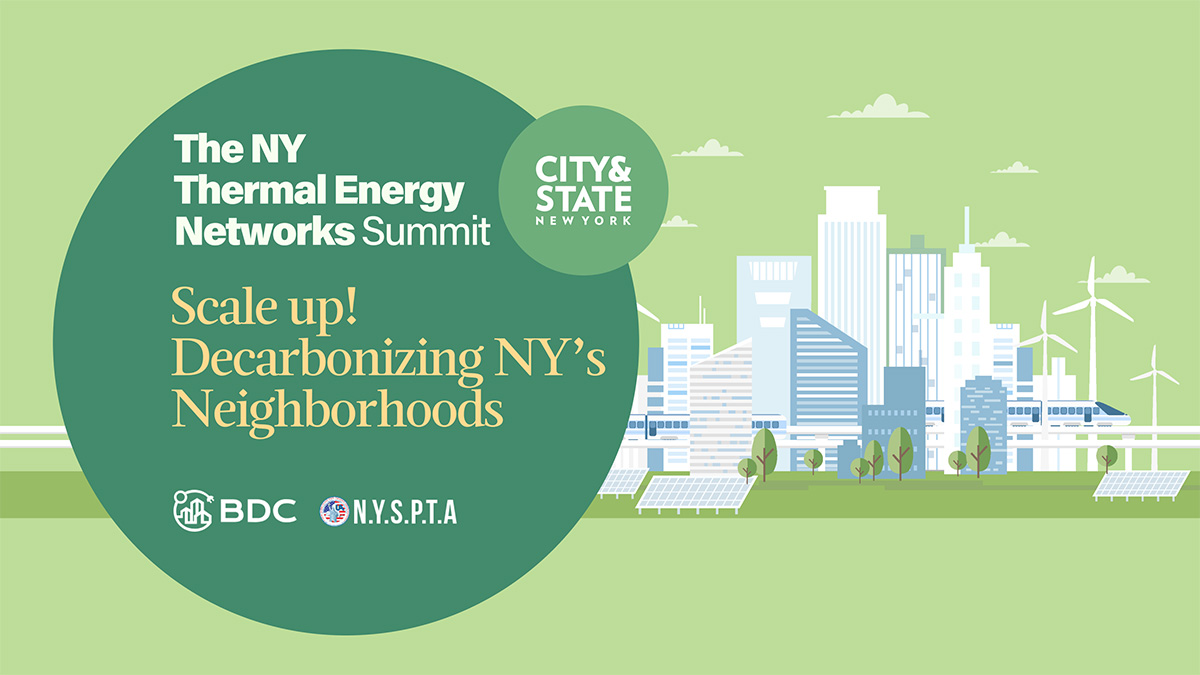
New York Thermal Energy Networks Summit Demonstrates that
Neighborhood Decarbonization is Coming to the Empire State
By Jason Brown, NY Communications Manager, BDC
Two years ago, in March of 2022, you would be hard-pressed to find anyone in Albany who could tell you what a thermal energy network was, or how it could be used to scale up neighborhood-scale building decarbonization in New York.
How times have changed. On March 6th this year in Albany, around 200 labor leaders, legislators and legislative staff, New York State government agency officials, environmental and climate justice advocates, and utility and climate tech executives gathered together at the 2024 NY Thermal Energy Networks Summit at the Albany Capital Center.
Subtitled Scale up! Decarbonizing NY’s Neighborhoods, the Summit examined how thermal energy networks function, where and how they can be deployed in New York, and why this type of neighborhood decarbonization solution will play an important role in helping the state meet its Climate Act mandate to reduce greenhouse gas emissions by no less than 85 percent from 1990 levels by 2050.
(Watch the New York Thermal Energy Networks Summit in full here.)
UpgradeNY Collaboration Helping Drive NY’s Transition to Clean Heat and Cooling
BDC’s NY Director, Lisa Dix, opened the summit by recognizing Governor Hochul and the New York State Legislature for having passed or implemented several first-in-the-nation climate initiatives over the past four years, including the state’s groundbreaking Utility Thermal Network  and Jobs Act (UTENJA). Lisa explained how UTENJA will help New York develop a new utility model for thermal energy networks and other types of neighborhood decarbonization solutions.
and Jobs Act (UTENJA). Lisa explained how UTENJA will help New York develop a new utility model for thermal energy networks and other types of neighborhood decarbonization solutions.
She also pointed out that UTENJA will help ensure that the state’s transition to clean heating and cooling is just and equitable. For example, the bill incorporates mandates from the New York Climate Act, which requires that many of the pilot projects be built in disadvantaged communities. In addition, the construction, operation, and maintenance of UTENJA projects will deliver homegrown, clean energy careers to New York’s union workforce, and also include pre-apprenticeship programs to assist with direct entry to labor unions for residents of disadvantaged communities.
Lisa concluded her opening remarks by pointing out how unusual it was for a bill like UTENJA to pass almost unanimously through both the New York State Senate and Assembly. The strong support for the bill was partially a result of the strong leadership of the legislators who sponsored and supported the bill. But it was also a result of the fact that a broad group of representatives from labor, the buildings industry, and environmental and climate justice organizations put aside their disagreements, and united to support a bill whose goal – a phased, managed, and just transition to neighborhood-scale clean heating and cooling for the state’s union workforce and disadvantaged communities – they all agreed on.
With the law passed this diverse group has continued to work together, forming a collaborative called UpgradeNY that continues to advocate for the decarbonization of New York’s built environment at scale through a local, union-led workforce. Already, this collaboration has secured wins towards the achievement of this vision, including a directive for the New York Power Authority (NYPA) to advance 15 shovel-ready thermal energy networks on state campuses and large facilities by 2026, and funding for an all-electric chiller as part of the University at Albany’s plan to develop a thermal energy network that will reduce the campus’s greenhouse gas emissions by 16%.
Thermal Energy Networks Will Play An Important Role in NY’s Decarbonization Strategy
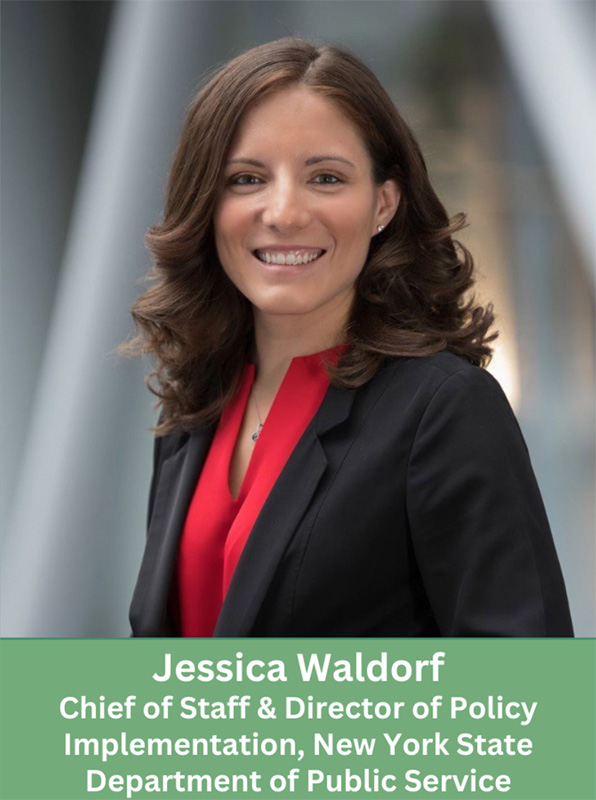 Following Lisa’s opening remarks, she welcomed Jessica Waldorf, Chief of Staff & Director of Policy Implementation at the New York State Department of Public Service to the stage to give the summit’s keynote address.
Following Lisa’s opening remarks, she welcomed Jessica Waldorf, Chief of Staff & Director of Policy Implementation at the New York State Department of Public Service to the stage to give the summit’s keynote address.
A dedicated public servant with an impressive track record helping shape New York’s clean energy transition, Jessica affirmed that New York’s state government and its private sector agree that thermal energy networks have an important role to play in the state’s overall decarbonization strategy. She then described this strategy, which includes Governor Hochul’s introduction of the Affordable Gas Transition Act (AGTA) in her Executive Budget. The AGTA would empower the Department of Public Service (DPS) and Public Service Commission (PSC) to direct utility companies to responsibly and affordably manage New York’s transition to cleaner energy sources.
She concluded her keynote by noting the scale and ambition of this transition: it has taken centuries for New York to build its existing energy systems, and conducting a wholesale shift to new energy systems will not be completed in an instant – but DPS and PSC are taking strategic steps to move away from fossil fuel use as soon as possible, in ways that recognize that their core mission is to ensure the delivery of safe, affordable, reliable and equitable utility services to New Yorkers.
Thermal Energy Networks 101
The first panel of the day, What are Thermal Energy Networks, gave attendees a shared language and understanding of what thermal energy networks are, guided by moderator Jessica Azulay, Executive Director at Alliance for a Green Economy (AGREE).
Jessica kicked off the panel with a brief but vivid description of thermal energy networks for anyone in the audience who was not familiar with them. First, she asked audience members to rub their hands together to generate thermal energy. She then asked them to clasp their hands 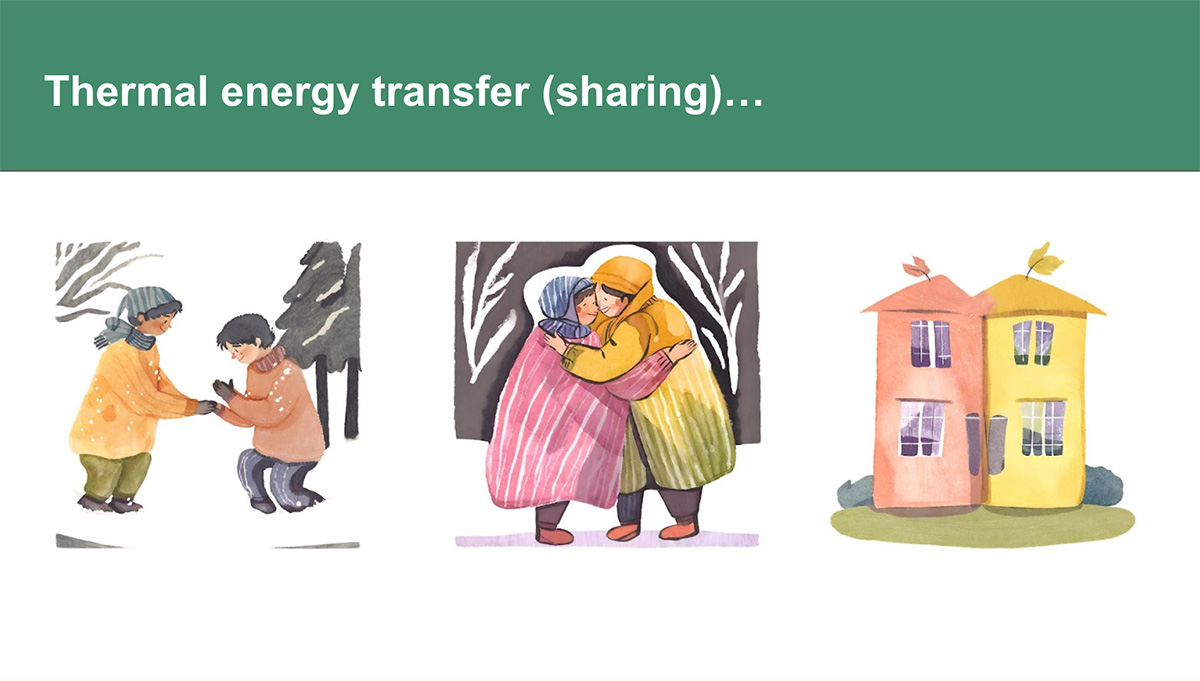 to share that energy. She then explained that thermal energy networks act just like your hands when they clasp each other, by using a network of water pipes to facilitate the sharing of thermal energy between buildings.
to share that energy. She then explained that thermal energy networks act just like your hands when they clasp each other, by using a network of water pipes to facilitate the sharing of thermal energy between buildings.
In addition to enabling buildings to “hug” and transfer energy with each other, these networks can also transfer energy from other energy sources – geothermal boreholes, wastewater systems, and data centers – to and from buildings. By combining this sharing of energy with heat pumps powered by electricity, thermal energy networks deliver buildings heat and cooling that is more efficient than using heat pumps alone – and much more efficient and cleaner than natural gas boilers and other technologies that use fossil fuel.
Jessica also explained why states like New York and others are adopting the technology – because thermal energy networks enable a more efficient, faster, and more equitable transition to clean heat and cooling. Jessica then introduced her panel, which included Indu, Director of Energy at SUNY’s University at Albany, Gregory C. Koumoullos, Clean Energy Project Manager at Con Edison, Vikas Anand, Vice President, Climate Solutions – North America at Danfoss LLC, and Trent Berry, Principal at Reshape Infrastructure Strategies Limited.
During the panel discussion, Indu explained how the thermal energy network being developed at the University at Albany will capture heat that many buildings don’t need and either transfer it to other buildings that do need it or store this energy for use later. The network will also allow them to add cooling to many of the University’s residential buildings, while also reducing climate emissions and other pollution resulting from the campus’s current combustion of fossil fuel – making the project a “win, win, win situation” for the University of Albany, the local community, and the planet.
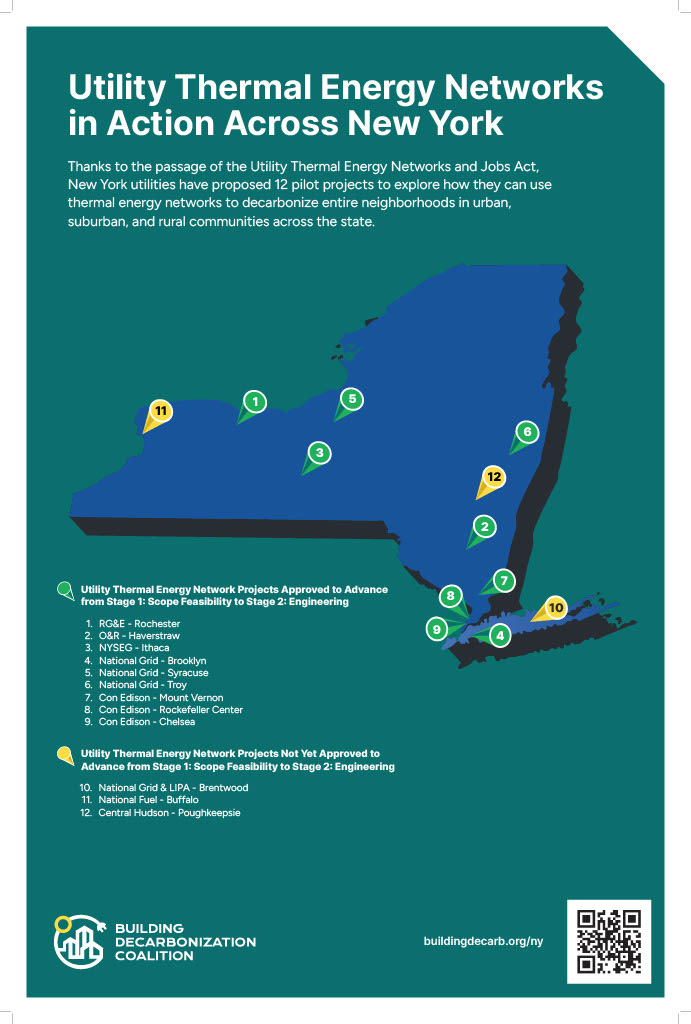
Gregory from Con Edison then talked about the three utility thermal energy network project proposals the utility has submitted and how these projects – one planned for Mt. Vernon New York, another planned for the Chelsea neighborhood of Manhattan, and the third planned for Rockefeller Center in Manhattan – will deliver valuable lessons to New York as the state continues to assess how to best develop thermal energy networks.
For example, the Mt. Vernon project will use geothermal boreholes as a source of thermal energy, and be built in a disadvantaged community with several one- to four-family homes, churches, and recreation centers. Meanwhile, the project in Chelsea would use waste heat from a data center to heat apartment buildings owned by the New York City Housing Authority. The utility’s Rockefeller Center project would use waste heat generated by three commercial buildings, while also transitioning these buildings from steam to electric heat pumps.
Vikas from Danfoss explained how thermal energy networks fit into his firm’s goal to provide its clients with the solutions they need to comfortably heat and cool commercial buildings, residential buildings, and industrial facilities while optimizing these buildings’ energy consumption.
Vikas went on to describe how poorly the U.S. is currently optimizing the way it heats its buildings. According to data from the Lawrence Livermore Academy, although 38% of the country’s energy supply is used to heat commercial, residential, and industrial facilities, 55% 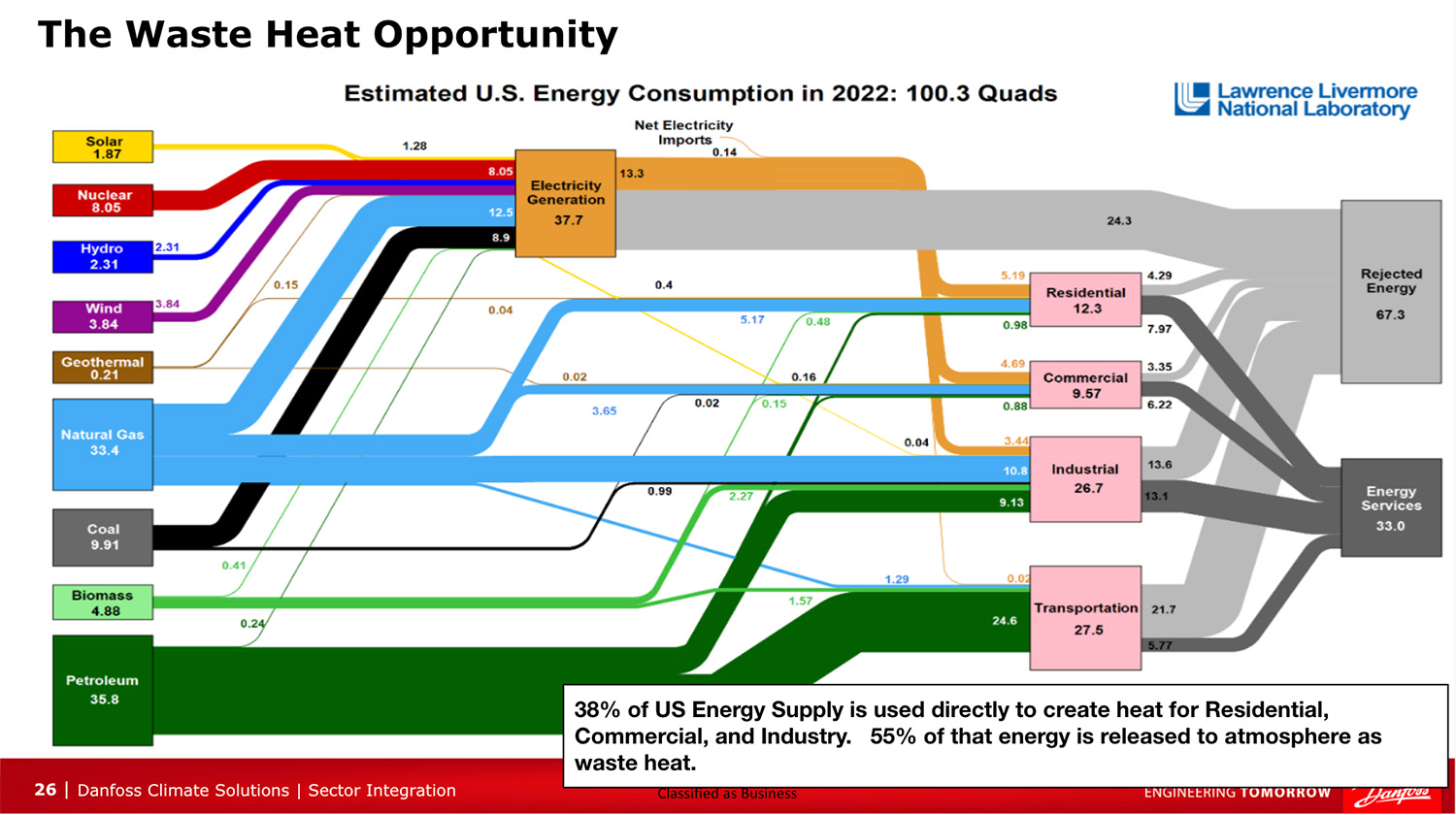 percent of this heat is released to the atmosphere as waste heat. If the U.S. could use thermal energy networks or other technologies to capture and use this waste heat, it would make it a lot easier for the country to achieve its climate goals. He concluded by noting that there is huge potential for thermal energy networks in states like New York, and as a manufacturer, Danfoss is ready to support these thermal energy projects.
percent of this heat is released to the atmosphere as waste heat. If the U.S. could use thermal energy networks or other technologies to capture and use this waste heat, it would make it a lot easier for the country to achieve its climate goals. He concluded by noting that there is huge potential for thermal energy networks in states like New York, and as a manufacturer, Danfoss is ready to support these thermal energy projects.
The last panelist, Trent from Reshape Infrastructure Strategies, congratulated New York for being one of the first U.S. states to show leadership on the topic of thermal energy networks. However, he noted that, while thermal energy networks might be new to New York, there are thousands of these types of systems – many being transitioned from using fossil fuels to cleaner sources of energy – currently operating across North America. Examples of these types of systems include many located near his home in Vancouver Canada, including the first sewer system heat recovery project in North America for the False Creek Neighbourhood Energy Utility in Vancouver, Canada.
In addition, he noted that, like New York, several countries in Europe are planning to use thermal energy networks to help them achieve their climate goals. For example, the United Kingdom wants to increase its use of thermal energy networks by 10X by 2050, while the Netherlands and France plan to increase their use of thermal energy networks by 5X by the same date. He concluded by noting that the most important part of the energy transition will be the “last mile” – the transition that takes place in homes and neighborhoods.
Labor Leading on Thermal Energy Networks
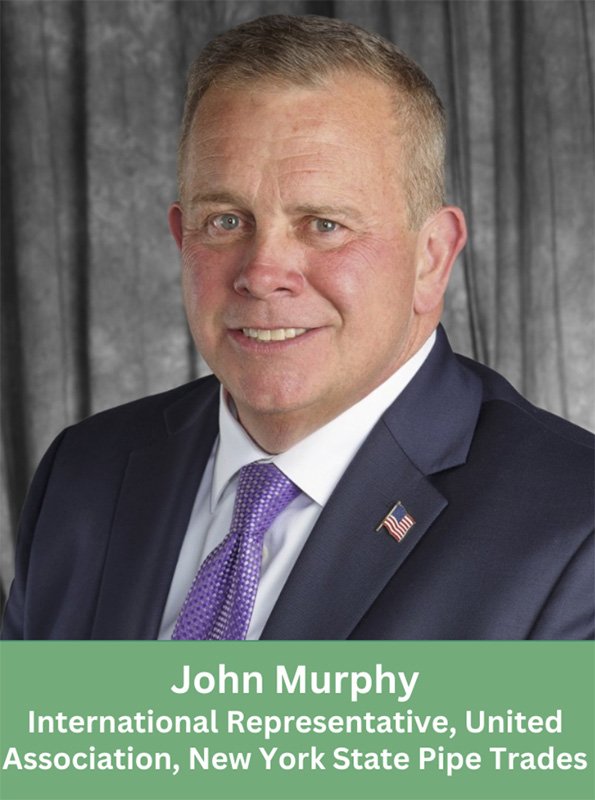 Following a short question and answer session with the panelists, John Murphy, International Representative for the United Association of Pipe Trades and a leader of the UpgradeNY collaboration, took the podium to fire up the room about the significance of New York’s thermal energy network leadership, and trade unions’ readiness to build these climate solutions.
Following a short question and answer session with the panelists, John Murphy, International Representative for the United Association of Pipe Trades and a leader of the UpgradeNY collaboration, took the podium to fire up the room about the significance of New York’s thermal energy network leadership, and trade unions’ readiness to build these climate solutions.
John pointed out that since New York passed UTENJA the states of Illinois, Maryland, Michigan, Vermont, and Rhode Island have all moved to pass similar bills that would encourage the development of thermal energy networks. At the same time, he called on New York to lead by example and help fund thermal energy networks at the University at Buffalo and SUNY Purchase.
He noted the state’s trade unions are ready to build and maintain these thermal energy networks. In fact, they are already training the next generation of the skilled workforce that New York will need to fully realize its clean energy future while creating family-sustaining union careers.
Thermal Energy Networks Reduce Grid Costs, Deliver Community Benefits
John then introduced Nicole Abene, Senior New York Legislative and Regulatory Manager at Building Decarbonization Coalition, as the moderator of the Summit’s final panel of the day, Mythbusting Thermal Energy Networks (TENs). Nicole welcomed her other panelists, which included John Murphy, Jared Rodriguez, principal at Emergent Urban Concepts, Melissa Mauro, principal engineer at National Grid, and Eric Walker, Energy Justice Senior Policy Manager at WE ACT for Environmental Justice.
The panelists first expanded on the summit’s previous discussion of how thermal energy networks work by showcasing some of their lesser-known benefits. Jared pointed out that as the electrification of buildings, transportation, and industry increases overall electricity demand, thermal energy networks can reduce the amount of stress this increased demand places on the grid. Specifically, thermal energy networks can reduce peaking loads by more than the 30% or 40% that stand-alone geothermal systems do – potentially saving billions in funds that would otherwise need to be spent on transmission, energy storage, and other types of electric grid infrastructure upgrades.
The panel also examined the community benefits delivered by thermal energy networks. Eric pointed out how thermal energy networks provide a way to scale community decarbonization across multiple building types and multiple populations, in a way that enables states to achieve both their climate goals and address their economic development agendas. For example, beyond expanding disadvantaged communities’ access to clean heating and cooling, thermal energy networks can also deliver jobs to the members of these communities.
John pointed out how New York already has a workforce ready to develop these thermal energy networks, with the New York State Pipe Trades having already set up modules to train all their members, not just apprentices, on how to install the high-density polyethylene (HDPE) pipes used in thermal energy networks. In fact, many of their members already have experience installing these pipes, since most semiconductor plants use HDPE piping. John explained that as long as there is certainty of work, the Pipe Trades can recruit from local communities and train this workforce to build thermal energy networks. The key thing is for New York to show that thermal energy networks are the future.
Melissa harkened back to Vikas’ point on how thermal energy networks can use waste heat when she described National Grid’s proposed UTENJA thermal energy networks. For example, its Syracuse project plans to use thermal energy from the city’s wastewater treatment plant to provide clean heat and cooling to commercial and multifamily residential buildings in the Inner Harbor neighborhood of downtown Syracuse – including possibly a new aquarium that might be built in the area. She also noted that thermal energy networks can be built to expand over time – for example, their Syracuse project could provide heating and cooling to a network up to two to four times larger than the current pilot.
Nicole pointed out that the Syracuse project addresses a common misconception about thermal energy network projects – that they are not static, but can be scaled and expanded after they are built.
Transforming New York’s Energy Systems with Homegrown, Clean Heat and Cooling
The day’s biggest takeaway? New York still has a lot of work to do if it hopes to equitably and affordably decarbonize its built environment. But thermal energy networks are a way for the state to implement a just, managed, and phased transition to zero-emissions heating and cooling while growing its clean heat economy and protecting existing and creating new union jobs.
With the passage of UTENJA and collaborations like UpgradeNY, New York has already positioned itself to be a national leader in using thermal energy networks to decarbonize its neighborhoods at scale. But the work is not yet done – New York still needs to implement the policies, like the NY HEAT Act, that will remove the barriers hindering the adoption of thermal energy networks. It needs to lead by example and invest in thermal energy network projects at state-owned facilities, like SUNY campuses, that will demonstrate to its union workforce that it prioritizes the creation of homegrown, clean energy jobs in its fight against climate change. Only then will it catalyze the development of the workforce and industry needed to fully realize thermal energy networks’ potential as a tool to eliminate carbon pollution from the state’s buildings, campuses, and other facilities.
BDC stands ready to collaborate with the state’s policymakers, union members, environmental and climate justice advocates, and utility representatives to continue to work together to advance thermal energy networks and transform New York’s energy system with homegrown, clean heat and cooling.
Want to stay up to date on building decarbonization policy and other developments in New York and across the rest of the United States? Sign up for BDC’s monthly newsletter, and follow us on X, Threads, and LinkedIn!
###
Watch the New York Thermal Energy Networks Summit in full here:
